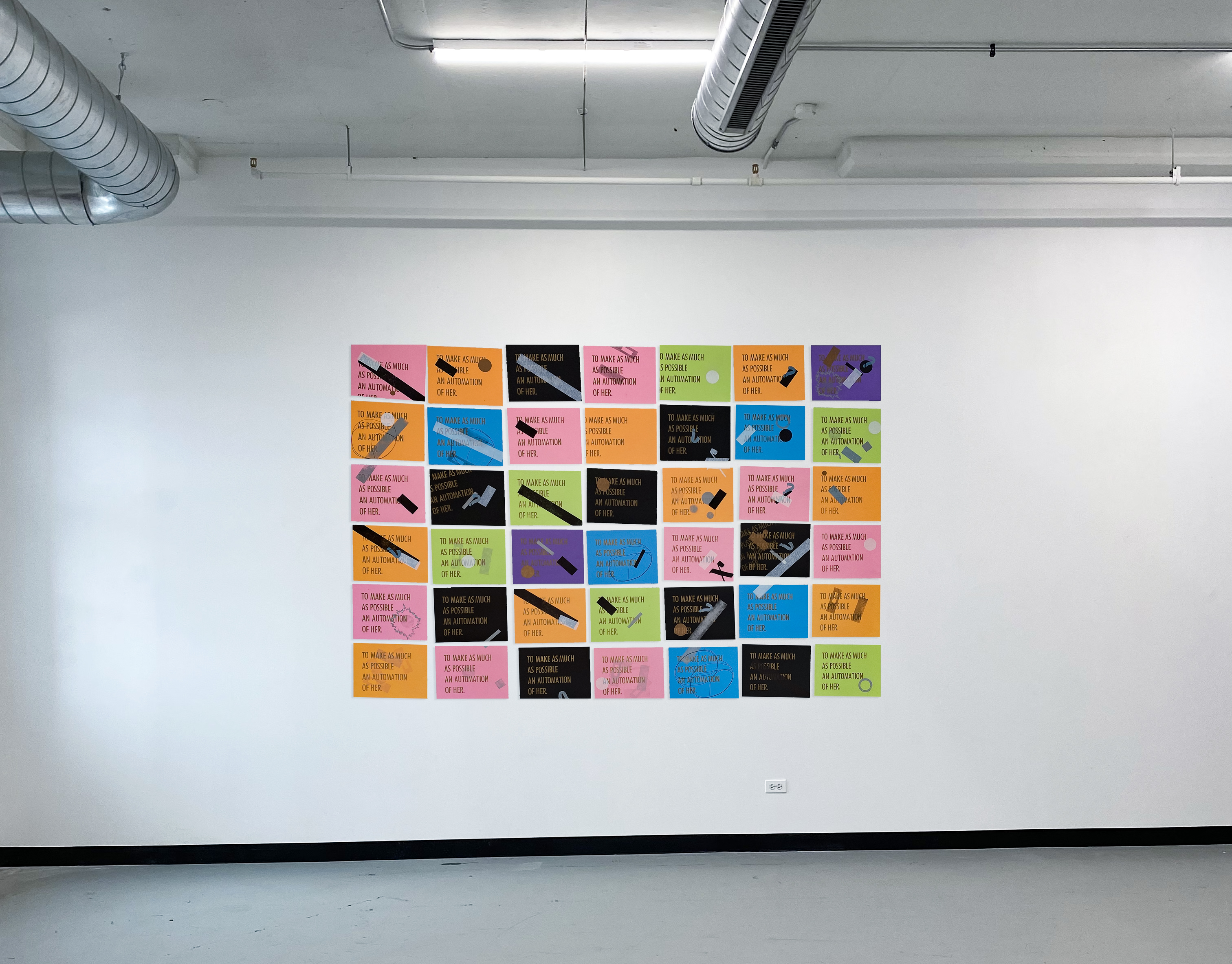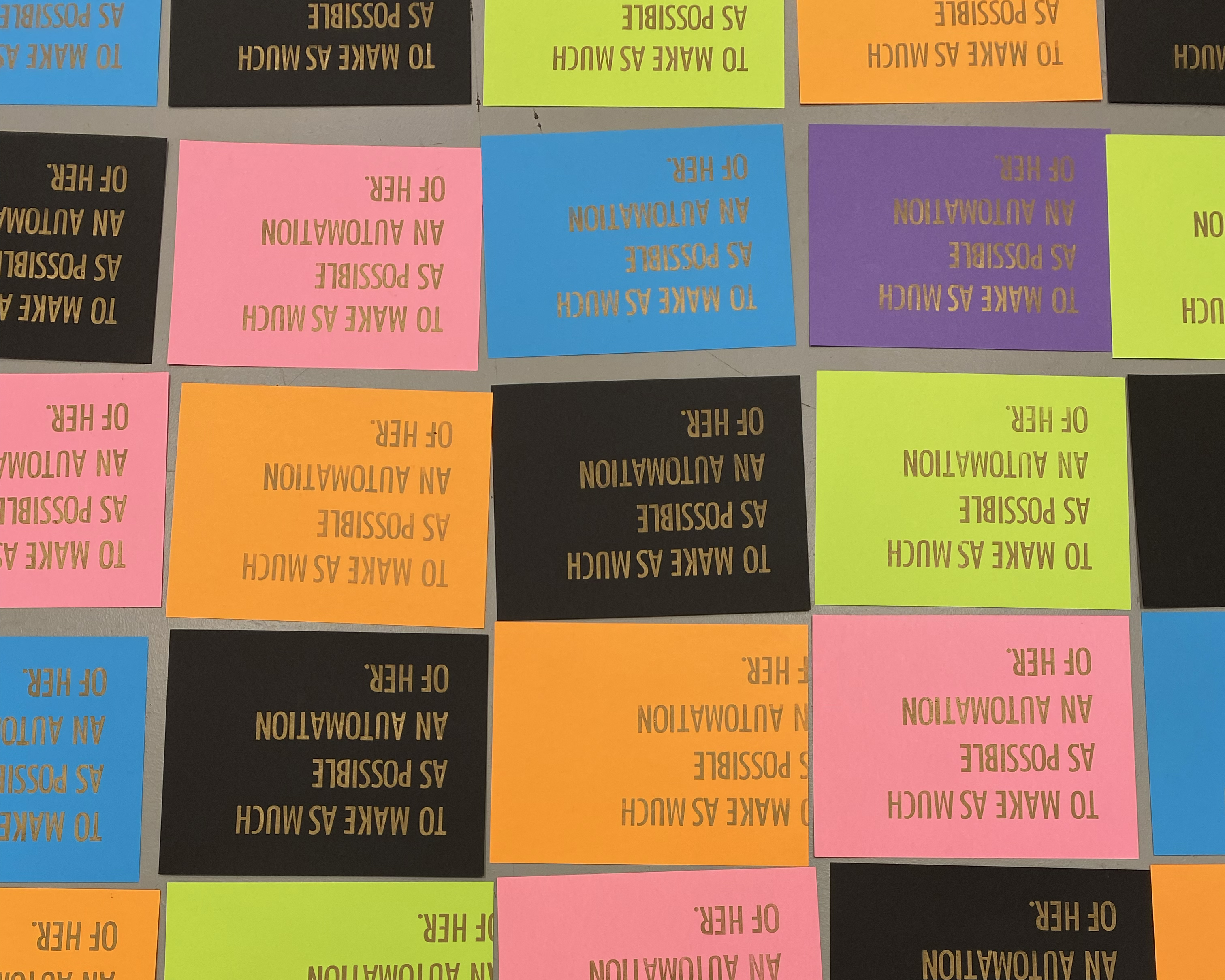


Letterpress print on
French Pop-Tone Paper
51” (H) X 77”(W)
French Pop-Tone Paper
51” (H) X 77”(W)
An Automation Of Her
This large-scale installation was produced in response to my research on the role of women in labor history. The impact of women on this sphere, especially in the printing trade, is often missing from textbooks and historical accounts. The International Typographical Union was one of the first unions to admit female members in 1869, creating various tensions. Most historians who acknowledge women typographers cite their contributions in relation to men, with arguments raised against the employment of women and the threat women represented to male typesetters.
In her 1980 article “Neither Printer's Wife nor Widow: American Women in Typesetting, 1830-1950,” author Mary Biggs focuses on women employed as typesetters in printing offices where they had no family connections. Among other things, the article lists Samuel B. Donnelly's 1899 testimony before the Industrial Commission, where he claimed that in Boston, although master printers employed as many women as they could find, they limited their advancement and controlled their female employees to "keep a woman on straight composition, to make as much as possible an automaton of her."
I was struck by Donnelly’s words, yet again testifying to the persistent cultural need for control of women and their laboring bodies. The 19th-century rhetoric, dehumanization, and distortion of facts to play up emotion and manipulate women reverberate today. Notably, women’s work today is highly limited through that other activity the word “labor” denotes–childbirth. At a time when state control is enforced through the reversal of Roe v Wade (in most cases without rape exceptions), it would not be a stretch to say that those of us who can give birth are effectively legislatively colonized by the state, automating the body to produce its subjects.
The 42 letter-sized panels that make this installation are imprinted with brass-inked words set in wood type. Using my Vandercook #4 printing press, I printed Donnelly’s words in multiples. The words are overprinted with organic and geometric abstract shapes. The abstract additions cancel out the automated action of printing the same words with rigidity. Instead, they create an organic pattern that overlays are redirects the eye as it moves across the assembled panels, now joined to create one large and dynamic composition.
January - March 2023
This large-scale installation was produced in response to my research on the role of women in labor history. The impact of women on this sphere, especially in the printing trade, is often missing from textbooks and historical accounts. The International Typographical Union was one of the first unions to admit female members in 1869, creating various tensions. Most historians who acknowledge women typographers cite their contributions in relation to men, with arguments raised against the employment of women and the threat women represented to male typesetters.
In her 1980 article “Neither Printer's Wife nor Widow: American Women in Typesetting, 1830-1950,” author Mary Biggs focuses on women employed as typesetters in printing offices where they had no family connections. Among other things, the article lists Samuel B. Donnelly's 1899 testimony before the Industrial Commission, where he claimed that in Boston, although master printers employed as many women as they could find, they limited their advancement and controlled their female employees to "keep a woman on straight composition, to make as much as possible an automaton of her."
I was struck by Donnelly’s words, yet again testifying to the persistent cultural need for control of women and their laboring bodies. The 19th-century rhetoric, dehumanization, and distortion of facts to play up emotion and manipulate women reverberate today. Notably, women’s work today is highly limited through that other activity the word “labor” denotes–childbirth. At a time when state control is enforced through the reversal of Roe v Wade (in most cases without rape exceptions), it would not be a stretch to say that those of us who can give birth are effectively legislatively colonized by the state, automating the body to produce its subjects.
The 42 letter-sized panels that make this installation are imprinted with brass-inked words set in wood type. Using my Vandercook #4 printing press, I printed Donnelly’s words in multiples. The words are overprinted with organic and geometric abstract shapes. The abstract additions cancel out the automated action of printing the same words with rigidity. Instead, they create an organic pattern that overlays are redirects the eye as it moves across the assembled panels, now joined to create one large and dynamic composition.
January - March 2023
